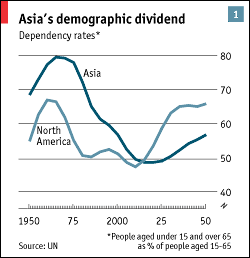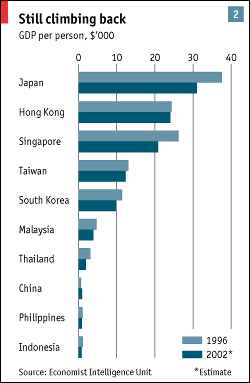
|
|
|
 |
|
EAST ASIA'S financial crisis of 1997-98 is gradually being re-evaluated. Many analysts now argue that, however cataclysmic it seemed at the time, it was also the best thing that could have happened to the region. As Nicholas Kristof puts it in “Thunder from the East”, co-written with Sheryl WuDunn, his wife and fellow New York Times journalist:
It entailed a terrible human cost, but it is also helping to destroy much of the cronyism, protectionism and government regulation that had burdened Asian business. The crisis helped launch a political, social and economic revolution that is still incomplete but that ultimately will reshape Asia as greatly as the fall of the Berlin wall reshaped Europe.
Mr Kristof, indeed, thinks that this revolution is going to wrench economic, diplomatic and military power from an American-led West.
|
|
|
 |
|
The belief that the crisis was a good thing for Asia is now taking hold at the region's brokerage houses and investment banks. They clearly have an interest in spreading the message, but it is not without substance. After all, the demographics that underpinned so much of the Asia-Pacific region's economic success for the past three decades or so still have some way to run. Since 1965, the ratio of the region's dependants—those 15 and under or 65 and over—to its working-age population has fallen from 80% (including lots of kids) to 55%. For the region as a whole it will reach its lowest point around 2015, at 49%. Yet in many of its constituent countries the ratio will be very much lower. By contrast, in the West the ratio is set to rise fast as the population ages (see chart 1).
This is what people mean by Asia's demographic dividend. Christopher Wood, equity strategist at CLSA Emerging Markets, compares the swelling cohort of working-age Asians (including India but excluding developed Japan) with America's post-war generation of baby-boomers. As that generation passed like a large animal through the digestive tract of the American economy (Mr Wood's herpetological metaphor), its numbers and sheer exuberance did much to drive America's consumption patterns and even its equity markets—at least until the bust at the end of the 1990s. Mr Wood predicts a similar effect on consumption and regional share prices from Asia's new baby-boomers.
There is nothing far-fetched about this. MasterCard's chief Asian economist, Yuwa Hedrick-Wong, says that, as a general rule, when an Asian's income passes $5,000 a year before tax, he has money in his pocket to burn. Very roughly, for every extra dollar earned over the $5,000 income threshold, 60 cents go on discretionary spending. How many discretionary spenders does that make? About 225m Asians outside Japan, Mr Wood reckons, using figures for GDP per head and adjusting them for the distribution of income.
Now for a bit of idle speculation. If Asia's annual average growth in per-head income between 2000 and 2020 were to equal the rate between 1980 and 2000 (that is, including the period of financial turmoil, when GDP in the crisis-hit economies plummeted), then the number of high spenders would rise to 340m in 2010 and 682m in 2020. But if income grew at the average rate in the ten years immediately before the crisis, the number would rise to 541m and 1.1 billion respectively.
Nor is that all. CLSA's regional economist, Jim Walker, has long argued persuasively that Asia's unofficial or black-market economy is as much as half the size of the official economy—and that it is a better engine of consumption because it is not taxed at source. After allowing for the black economy, the number of discretionary consumers in 2020 may have risen to as much as 1.4 billion. “Asia's billion boomers”, as CLSA puts it, no longer seems outlandish. It could lead to a virtuous circle as the high savings which hitherto have fuelled much of Asia's export-driven growth are drawn into domestic consumption. That, in turn, would encourage a more balanced regional development, less dependent upon exports and, above all, upon the increasingly unreliable-looking health of the American economy.
Not outlandish, and certainly desirable. Yet this survey will argue that post-crisis Asia is still very far from realising its economic potential; and that rickety and hugely inefficient financial systems remain the biggest economic constraint. The radical transformation of the region's financial systems needed to underwrite optimistic assumptions about future growth has, by and large, yet to take place.
Certainly, an economic recovery in the region has begun. In 2002, East Asian growth probably averaged nearly 5%, after 7% and 3% respectively in 2000 and 2001—a little wobbly, perhaps, but a vast improvement on the late 1990s. However, as Joan Zheng at J.P. Morgan Chase in Hong Kong points out, in dollar terms only two economies, China's and Hong Kong's, are now at higher levels than before the financial crisis—and these two economies were not directly hit by it. China escaped because its currency is only partially convertible (which meant that its technically insolvent banking system was not exposed), Hong Kong because of its first-world banking system and abundant foreign-exchange reserves. As for the rest of the region, most economies have not even clawed their way back to pre-crisis levels once steep falls in their exchange rates are taken into account.
For much of the region, the crisis destroyed wealth on a massive scale and sent absolute poverty shooting up. In the banking system alone, corporate loans equivalent to around half of one year's GDP went bad—a destruction of savings on a scale more usually associated with a full-scale war. In a number of countries, governments have helped to take these loans off banks' books, in the hope of cleaning up the banking system and encouraging banks to start lending again. Yet, notably in Indonesia and Thailand, they have often dithered over dealing with the bad loans and with the companies responsible for them—even though they know that putting off the problem ensures that the eventual cost will be very much higher.
Meanwhile, several economies are turning a blind eye towards banks that continue to lend to the politically well-connected, or that tolerate companies not keeping up with repayments, a nod-and-a-wink known in the trade as forbearance. Such practices prevent capital being allocated in the most efficient way. They stop the region from drawing a line under the past and looking to the future.
To be fair, in some quarters the lessons of the crisis have been swiftly learnt. South Korea—a country that by the mid-1990s appeared to have graduated permanently to the ranks of the developed world, only to find itself on the brink of bankruptcy in late 1997—is the clearest example of how quickly reforms can produce results if the initiative is seized. The government took many bad loans away from the banks and sold them to all comers, even foreigners, if necessary at knock-down prices. It drastically slimmed down the banking sector (again inviting in foreigners) and liquidated some of the most heavily indebted and least profitable Korean companies. As a result, the Korean economy has been transformed. Not only are today's export-oriented conglomerates, the chaebol, in far better health, but new sources of growth, notably domestic demand and consumer credit, have appeared, and foreign direct investment (FDI) has soared. Since the crisis, over 1m new jobs have been created, and the country appears to be climbing back towards a growth rate of 5-7% a year.
Some South Koreans compare the magnitude of the economic shock of 1997-98 to the Korean war. Women lined up to donate their wedding rings to saving the country's finances. It took a national crisis for South Korea to turn from an inward-looking nation to one that embraced foreign capital, change and competition. The country's economic transformation required radical political change, led by Kim Dae-jung, once an imprisoned dissident. Whatever the later mis-steps in Mr Kim's presidency, in his early days he helped to make Koreans face up to their economy's shortcomings. Still, South Korea is the exception, and questions remain even there—particularly about the continued high indebtedness of many companies, and about the adequacy of the banks' experience in dishing out credit to consumers.
In Indonesia, the crisis fostered a political revolution that unseated the long-standing dictator, Suharto, and ushered in democracy. Since then, no profound economic revolution has followed the political one. Instead, reforms have been introduced incrementally, amid much muddle and corruption, and have often appeared to make little progress.
The government, having taken over most of the banking sector's non-performing loans, now controls great swathes of the Indonesian economy, from telecoms to plantations, and has nationalised nearly all the banks as well. Yet it has done far too little to get these assets swiftly off its books. As a result, foreign investment continues to leave the country, Indonesian Chinese businessmen keep their flight capital in Switzerland or Singapore, banks refuse to lend money to those that have a use for it, and the fiscal situation, though better than it was, still looks difficult. “This is a country that was never ready for reform, but was asked to undertake multiple reforms at once,” says a senior Indonesian banker. Without political will and a national consensus, as in South Korea, that was bound to cause trouble.
Progress in financial reform matters, not least because the demographic window of a growing working-age population will not be open for long. It is not necessarily a bad thing for Asia's traditionally high savings rates to fall as consumption rises, but it does mean that savings will need to be allocated far more efficiently than in the past—at a time when rapidly ageing populations will be putting fresh demands upon financial resources. Smaller households and more working women mean that the traditional, extended Asian family, where the old move in with their children and expect to be cared for, is on its way out. Increasingly, people want to push the costs of caring for the elderly on to the state. For instance, by 2025, China's population, now 1.3 billion, will have risen to 1.5 billion, and will contain the same proportion of elderly people (one-fifth of the total) as the OECD economies have today. But whereas North America and Europe have had the best part of a century to organise their pension systems (and have yet to resolve huge problems), China has only a quarter of that time to get ready. As it is, the state faces a $100 billion-200 billion unfunded pension liability for its urban residents alone. What will happen when countryside folk dare to demand equal treatment?
The challenge, then, is to develop regional banking and capital markets that are efficient, deep and well-regulated, so that savings can be channelled to where they get the highest returns. Today, Asia's financial sectors are fragmented, parochial, illiquid and poorly policed; they misprice capital. In addition, capital markets are under-represented, because banks are unhealthily dominant. Although Asia (including Japan) accounts for over half of mankind, one-third of the world's GDP and one-quarter of its exports, the region's share of worldwide equity-market capitalisation is only 16%—or merely 5% without developed Japan. To the optimists at Asia's investment banks, that is just one more reason to forecast a secular bull market in Asian equities, as we shall see later. But it is also a measure of how much emerging Asia still has to do in the financial area.
Defining Asia is the stuff of many debates. Lumping together a region where annual income per head ranges from $280 (Laos) to $31,000 (Japan) is bound to be problematic. For the rest of this survey, Asia generally means East and South-East Asia, and in particular the economies of South Korea, the Philippines, Indonesia, Thailand and Malaysia that were hit hard by the crisis of 1997-98.
|
|
|
 |
|
There is no need to worry too much about Singapore and Hong Kong. True, Singapore is finding itself in the wrong place at the wrong time, surrounded by struggling economies when its own specialities, high technology and electronics, are also being knocked by a slump in American demand; and Hong Kong is agonising loudly about its role in the Chinese economy. Yet the prosperity of the two city-states is pretty much secure, however much they like to fret about financial competition—from each other, or even Shanghai. By the same token, both offer useful examples for their poorer neighbours about how to develop financial markets, and how to think about their future challenges, even if they sometimes fall short in political imagination or public participation.
Japan, so overwhelmingly the region's biggest economy, enters this survey's calculations when it has lessons to teach the rest of Asia. Regrettably, the biggest lesson is the baneful effect on economic growth of not tackling bad debts in the banking system. The consulting arm of Ernst & Young estimates that Asia has $2 trillion of non-performing loans, of which $1.2 trillion reside in Japan—and that is over a decade after the country's asset bubble burst. What is more, the aggregate figure has not shrunk even though banks have got rid of around $300 billion of bad loans since 1997, so fast are other loans souring. The prime minister, Junichiro Koizumi, has now launched a last-ditch attempt to sort out the banks. It will fail, unless the country's deflation is cured at the same time.
Japan's domestic shortcomings also affect the region more directly, in that for most of the past decade, and particularly since 1997, stricken Japanese banks have withdrawn from the region, and their absence is now almost complete. Asians, in other words, have had to rebuild their financial systems without any private-sector help from their richest neighbour, at a time when foreign private investment is crucial for their transformation.
India, though a huge country, is not covered by this survey, partly because the line has to be drawn somewhere, and partly because it is still an inward-looking economy that attracts relatively little foreign investment, was scarcely affected by the regional crisis of 1997-98 and plays a very much smaller role in world trade today than it once did. For instance, despite its importance in software programming, India has no part in the production chains that are an increasingly striking aspect of regional trade patterns in East Asia. Cambodia, Laos, Myanmar, Vietnam and benighted North Korea, because of their isolation and socialist backwardness, are regrettably also left out of the calculations.
China, by contrast, plays a large and growing part in world trade and now accounts for nearly 5% of world exports, seven times as much as India. It is by far the biggest link in the East Asian production chain. China is the dominant recipient of foreign direct investment ($55 billion in 2002) going to developing countries, and last year may have surpassed even America as the world's biggest recipient. Its $600 billion of non-performing loans equal those of the rest of emerging Asia put together. The success or otherwise of China's financial reforms will have a bearing on the whole region. Although the country did not itself suffer a crisis in those dark days of 1997-98, it first acknowledged the huge shortcomings in its own financial system when it saw its neighbours' systems laid bare. It is emphatically included in this survey.